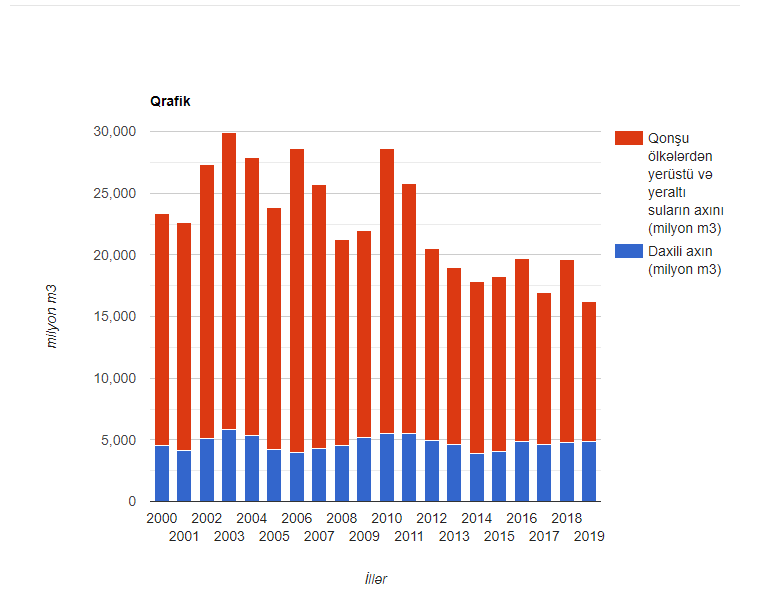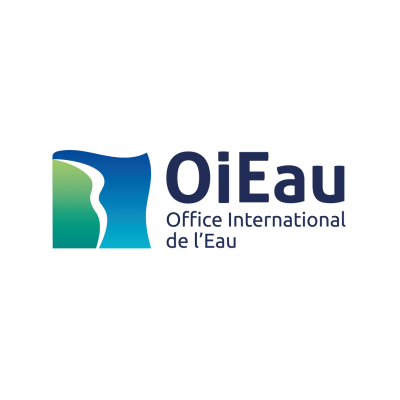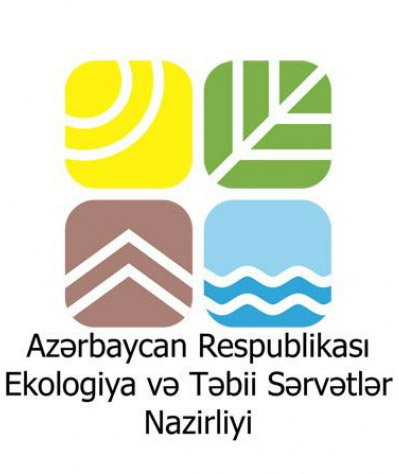| Ekoportal |
|---|
|
|
Renewable freshwater resources
A brief summary
Are renewable fresh water resources sustainable in Azerbaijan?
Change trend of renewable freshwater resources (2000-2019)

Azerbaijan is one of the countries facing serious water pressures and problems, where the average annual water consumption index is 52.7%. The water consumption index was estimated at 78% in 2019 ( see Freshwater Taken indicator for more information ). In general, the natural water balance of Azerbaijan is highly dependent on extraneous flows from upstream basins. The country's upstream water dependency ratio is about 79% on an annual average. As a result of the climate, the effective precipitation is only 12% of the total flow, which constitutes the bulk of the inland flow. Nevertheless, the average annual total recoverable fresh water resources are about 22 747 million m 3is On the other hand, since 2000, there has been a serious decrease in recoverable fresh water resources, from 23312.2 million m 3 to 16 223 million m 3 in 2019 .
Kura and Araz rivers are large rivers that flow into Azerbaijan and play an important role in the overall water balance of the country. There are 140 large and small reservoirs in the republic . Among them, 6 major reservoirs are: Mingachevir, Shamkir, Araz, Yenikand, Varvara, Jeyranbatan and Sarsang. The volume of each in Azerbaijan is 1 mln. There are 61 reservoirs of more than m 3 . The Mingachevir Reservoir on the Kura River is the largest reservoir and has a capacity of 15,730 million m3 , its water is used for energy production and irrigation. The Samur River plays an important role in drinking water supply and irrigation in the northeastern zone of Azerbaijan and the Absheron Peninsula through the Samur-Absheron Canal.
It should be noted that due to highly variable climatic conditions, renewable fresh water resources differ significantly from year to year. The magnitude of change in recoverable freshwater resources is 29% below or 32% above the annual average. Such high differences create inconsistencies and risks in the management of water resources across the country. The record level of renewable water resources was observed as 29,935.1 million m 3 in 2003, and the lowest level of available water resources was 16,223 million m 3 in 2019 .
The population of Azerbaijan in 2019 was 9.9 million people. The population increased by 24.2% between 2000 and 2019. In parallel, demand for water withdrawals also increased by 15%, while recoverable freshwater resources decreased by 30.4% over the same period. This, in turn, resulted in a significant decrease in annual renewable freshwater resources per capita, as this indicator decreased from 2902.1 m 3 /capita in 2000 to 1 625.4 m 3 /capita in 2019 . The long-term acute water shortage situation in the country is a warning of the need to improve water efficiency in the near future.
Features of the indicator
Description of the pointer
This indicator covers the country's renewable freshwater resources and the main components needed to assess their availability. Renewable freshwater resources (surface and groundwater) are replenished through precipitation (minus evaporation), which results in runoff into rivers and recharge of aquifers (inflow), as well as surface water and groundwater runoff from neighboring countries. through (outflow from upstream areas or internal flow) is restored. This indicator also includes the flow of surface water and groundwater to neighboring countries and the sea.
Unit of measurement
In million cubic meters per year (million m 3 ).
Justification
Rationale for indicator selection
Renewable freshwater resources are of major ecological and economic importance. Their distribution varies widely between and within countries. Pressures on freshwater resources result from overexploitation and environmental degradation. Linking renewable freshwater resources to freshwater withdrawals is central to ensuring freshwater sustainability.
The indicator provides information on measuring the state of fresh water resources in the country and its periodic changes.
Scientific references
- UNECE, 2011. Azerbaijan - Second Environmental Performance Review, United Nations Economic Commission for Europe, Environmental Performance Review Series No. 31, e-ISBN 978-92-1-117035-1, New York and Geneva.
- UNECE, 2018 . Guidelines for the Application of Environmental Indicators, C1. - Description of renewable freshwater resources.
- UNECE, 2018. Guidelines for the Application of Environmental Indicators, Glossary of Terms – C1. Renewable freshwater resources.
- UNSD, 2012. International Recommendations on Water Statistics, Statistics Division of the Department of Economic and Social Affairs, Statistical Papers, Series M# 91,m ST/ESA/STAT/SER.M/91, ISBN: 978-92-1-161545-6 , New York.

